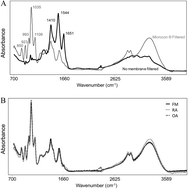A bloodspot-based diagnostic test for fibromyalgia syndrome and related disorders
Abstract
The aim of this study was to investigate the ability of a rapid biomarker-based method for diagnosis of fibromyalgia syndrome (FM) using mid-infrared microspectroscopy (IRMS) to differentiate patients with FM from those with osteoarthritis (OA) and rheumatoid arthritis (RA), and to identify molecular species associated with the spectral patterns. Under IRB approval, blood samples were collected from patients diagnosed with FM (n = 14), RA (n = 15), or OA (n = 12). Samples were prepared, placed onto a highly reflective slide, and spectra were collected using IRMS. Spectra were analyzed using multivariate statistical modeling to differentiate groups. Aliquots of samples also were subjected to metabolomic analysis. IRMS separated subjects into classes based on spectral information with no misclassifications among FM and RA or OA patients. Interclass distances of 15.4 (FM vs. RA), 14.7 (FM vs. OA) and 2.5 (RA vs. OA) among subjects, demonstrating the ability of IRMS to achieve reliable resolution of unique spectral patterns specific to FM. Metabolomic analysis revealed that RA and OA groups were metabolically similar, whereas biochemical differences were identified in the FM that were quite distinctive from those found in the other two groups. Both IRMS and metabolomic analysis identified changes in tryptophan catabolism pathway that differentiated patients with FM from those with RA or OA.


 Please wait while we load your content...
Please wait while we load your content...